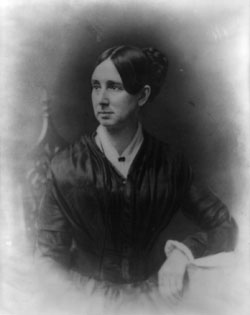|
Dorothea Lynde Dix was born
in the town of Hampden,
Maine, and grew up in
Worcester and Boston. She
became a teacher and then a
social reformer for the
treatment of the mentally
ill. At the age of
thirty-nine she volunteered
to teach a Sunday School
class for women inmates at
East Cambridge Jail. It was
there, seeing the deplorable
conditions of the jail and
the mentally ill mixed in
with prostitutes, drunks,
and criminals that she began
her crusade to change how
the mentally ill were being
treated. By the time she was
fifty-four she had covered
half of the United States
and Europe inspecting
institutions for
mistreatment. She played a
major role in founding 32
mental hospitals and 15
schools for the feeble
minded.
She traveled from state to
state collecting data on
poor houses and alms houses.
For each state she visited
she would prepare a
memorial bearing her
carefully documented
findings. The memorial was then delivered
to the state government by
a friendly and well-known
political figure. For over a
decade her memorials were
presented in state after
state, often with gratifying
results.
During the Civil War, Dix
was appointed Superintendent
of Union Army Nurses.
Unfortunately, the qualities
that made her a successful
crusader (independence,
single-minded zeal), did not
lend themselves to managing
a large organization of
female nurses. At odds with
Army doctors, she was
gradually relieved of real
responsibility and would
consider this chapter in her
career a failure. At the
war's conclusion, Dix
returned to her work on
behalf of the
|
 |
|
mentally ill.
At the age of 80, she gave
in to physical infirmity and
went to live in the guest
rooms of the state mental
hospital in Trenton, New
Jersey, an institution she
helped to establish more
than three decades before.
She lived there five years,
then died on July 18, 1887. |
| |
|
How she influenced the
hospital: |
|
In 1845 Dix presented a
memorial to Pennsylvania
lawmakers which resulted in
the establishment of the
Pennsylvania State Lunatic
Hospital and Union Asylum
for the Insane that same
year. She was instrumental
in the founding of the
hospital and she continued
to show interest in the
hospital even after it was
open to patients. She
collected a fund from the
citizens of Philadelphia for
the benefit of the patients;
with this she furnished them
with a bowling alley, two
buildings for reading rooms
and museums, horses and
a carriage, magic lanterns
with slides, musical
instruments, and books. In
consideration of the great
services Dix rendered, in 1853
the board of trustees
authorized the
superintendent to receive
and treat without charge any
one person recommended for
admission by Dix. One
patient recommended by her
entered the hospital March
6, 1853, and remained until
her death in 1895. After the
death of Dix the trustees of
the Philadelphia fund
presented the hospital with
her life-size portrait; this
portrait still hangs in the
Administration Building to this day
(2009). |
|
![]()